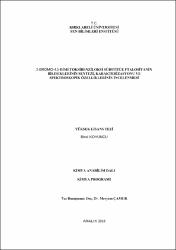2-Bromo-4,5-Dimetoksibenziloksi Sübstitüe Ftalosiyanin Bileşiklerinin Sentezi, Karakterizasyonu ve Spektroskopik Özelliklerinin İncelenmesi

Göster/
Erişim
info:eu-repo/semantics/embargoedAccesshttp://creativecommons.org/licenses/by-nc-nd/3.0/us/Tarih
2018Üst veri
Tüm öğe kaydını gösterKünye
Koyuncu, B. (2018). 2-Bromo-4,5-Dimetoksibenziloksi Sübstitüe Ftalosiyanin Bileşiklerinin Sentezi, Karakterizasyonu ve Spektroskopik Özelliklerinin İncelenmesi. Kırklareli Üniversitesi Fen Bilimleri Enstitüsü, Kırklareli.Özet
Linstead tarafından ismi antik Yunan edebiyatında geçen kaya yağı ‘‘naphtha’’ ve koyu mavi anlamındaki ‘‘cyanine’’ kelimelerden türetilen ftalosiyaninler, yirminci yüzyılın başlarında şans eseri keşfedilmiş bileşiklerdir. Metalli ve metalsiz olarak sentezlenebilen ftalosiyaninler 18-? elektrona, mavi ve yeşil arasında renklere sahiptirler. Ftalosiyaninler insan yapımı makrohalkalı bileşiklerdir. İlk sentezlendikleri andan itibaren kimyasal ve fiziksel özelliklerinden dolayı boya ve pigmentlerin önemli bir sınıfı olmuşlardır. Günümüzde ftalosiyaninler kataliz, fotodinamik terapi (PDT), kimyasal sensörler ve optik materyaller gibi birçok uygulamalı bilimlerde kullanılmaktadır ve ftalosiyaninler üzerine birçok araştırma yürütülmektedir. Ftalosiyaninlerin çözünürlükleri, fiziksel ve kimyasal özellikleri, sentezlendikleri ligandın yanı sıra ftalosiyanin merkezinde yer alan metal iyonuna bağlı olarak da değişmektedir. Ftalosiyaninler görünür ışığın kırmızı bölgesinde yoğun absorpsiyon kapatesine sahiptirler. Ayrıca uzun triplet hal durumuna ve etkili singlet oksijen üretebilme kapasitelerine sahiptirler. Bu yüzden bu bileşiklerin son yıllarda ikinci nesil fotoduyarlaştırıcı maddeler olarak bir tür kanser tedavisi olan PDT’de kullanılması önem kazanmıştır. Bu çalışmada 2-bromo-4,5-dimetoksibenzil alkol kullanılarak daha önce sentezlenmemiş olan yeni metallo ftalosiyanin bileşikleri sentezlenmiştir. Ftalosiyaninlerin sentezinde çinko (Zn), magnezyum (Mg) ve indiyum (In) metallerin tuzları kullanılmıştır. Çalışmanın ilk kısmında 2-bromo-4,5-dimetoksibenzil alkol, sırasıyla 3- nitroftalonitril ve 4-nitroftalonitril ile dimetilformamid (DMF) içinde potasyum karbonat (K2CO3) varlığında reaksiyona sokulmuştur. Reaksiyon sonunda 3-(2- bromo-4,5-dimetoksibenziloksi)ftalonitril (1) ve 4-(2-bromo-4,5- dimetoksibenziloksi)ftalonitril (2) ligandları elde edildi. Çalışmanın ikinci kısmında bu iki ligand uygun metal tuzları ile, 1,8-diazabisiklo[5.4.0]undek-7-ene (DBU) varlığında n-hekzanol içinde reaksiyona sokuldu. Reaksiyon sonunda gibi non- periferal ve periferal sübstitüe metalli ftalosiyanin bileşikleri (np-ZnPc, np-MgPc, np-InClPc, p-ZnPc, p-MgPc, p-InClPc) sentezlendi. Sentezlenen bileşiklerin yapılarının aydınlatılması için FT-IR, 1H-NMR ve MALDI-TOF spektrumları kullanılmıştır. Ftalosiyanin bileşiklerinin fotofiziksel ve fotokimyasal özelliklerinin araştırılması için UV-Vis ile floresans spektrofotometre cihazları kullanılmıştır. Bu tez ile sentezlenen 2-bromo-4,5-dimetoksibenziloksi sübstitüenti içeren yeni tür ftalosiyaninler hakkında elde edilen sonuçlar, literatürde ftalosiyaninler hakkında bulunan bilgiler ile derlenip sunuldu. Phthalocyanines are compounds discovered by chance in the early twentieth century which derived by Linstead from naphtha and cyanine, the words mean rock oil and dark blue in ancient Greek literature. Phthalocyanines can be synthesized as metal and metal-free which have 18-? electrons, blue and green colors. Phthalocyanines are man-made macrocyclic compounds. Since the first synthesized, they were an important class of dyes and pigments due to their chemical and physical properties. Today, phthalocyanines are used in many applied sciences such as catalysis, photodynamic therapy (PDT), chemical sensors and optical materials and many researches are carried out on phthalocyanines. The solubility, physical and chemical properties of the phthalocyanines vary depending on the ligand, as well as the metal ion at the center of the phthalocyanine. Phthalocyanines have an intense absorption capacity in the red region of visible light. In addition, they have long triplet state and effective singlet oxygen production capacity. Therefore, the use of these compounds as a second-generation photo- sensitizing agent in PDT, a type of cancer treatment, has gained importance in recent years. In this study, new metallo phthalocyanine compounds were synthesized which were not previously synthesized using 2-bromo-4,5-dimethoxybenzyl alcohol. Zinc (Zn), magnesium (Mg) and indium (In) metal salts were used in the synthesis of phthalocyanines. In the first part of the study, 2-bromo-4,5-dimethoxybenzyl alcohol was reacted with 3-nitrophthalonitrile and 4-nitrophthalonitrile in the presence of potassium carbonate (K2CO3) in dimethylformamide (DMF), respectively. At the end of the reaction, 3- (2-bromo-4,5-dimethoxybenzyloxy)phthalonitrile (1) and 4-(2-bromo-4,5- dimethoxybenzyloxy)phthalonitrile (2) ligands were obtained. In the second part of the study, these two ligands were reacted with the appropriate metal salts in n- hexanol in the presence of 1,8-diazabicyclo [5.4.0] undec-7-ene (DBU). At the end of the reaction, non-peripheral and peripheral metallo phthalocyanine compounds (np-ZnPc, np-MgPc, np-InClPc, p-ZnPc, p-MgPc, p-InClPc) were synthesized. For the elucidation of the structure of the synthesized compounds; FT-IR, 1H-NMR and MALDI-TOF were used. Photophysical and photochemical properties of the phthalocyanine compounds were investigated using UV-Vis and fluorescence spectrophotometer devices. The results of the novel phthalocyanines containing the 2-bromo-4,5- dimethoxybenzyloxy substituent synthesized by this thesis are compiled and presented in the literature with the information on phthalocyanines.
Koleksiyonlar
- Tez Koleksiyonu [88]
Aşağıdaki lisans dosyası bu öğe ile ilişkilidir:



















